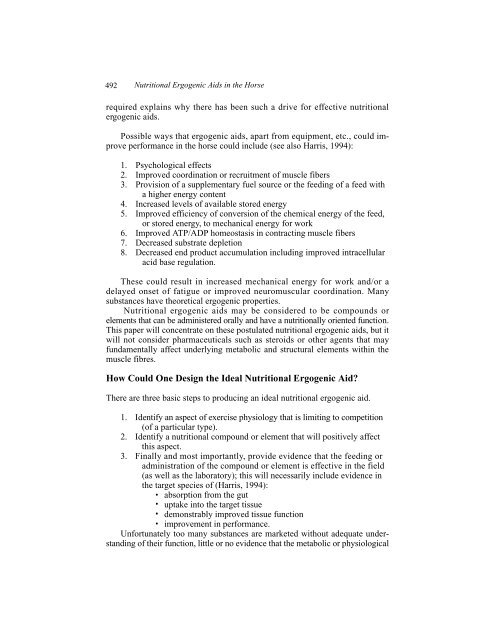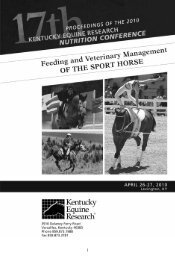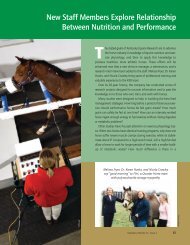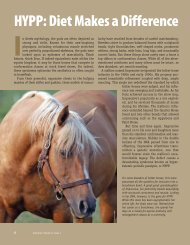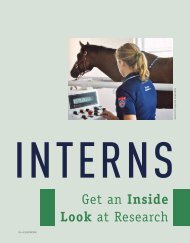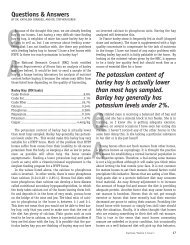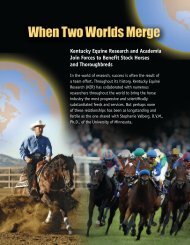Nutritional Ergogenic Aids in the Horse - Kentucky Equine Research
Nutritional Ergogenic Aids in the Horse - Kentucky Equine Research
Nutritional Ergogenic Aids in the Horse - Kentucky Equine Research
- No tags were found...
Create successful ePaper yourself
Turn your PDF publications into a flip-book with our unique Google optimized e-Paper software.
492 <strong>Nutritional</strong> <strong>Ergogenic</strong> <strong>Aids</strong> <strong>in</strong> <strong>the</strong> <strong>Horse</strong>required expla<strong>in</strong>s why <strong>the</strong>re has been such a drive for effective nutritionalergogenic aids.Possible ways that ergogenic aids, apart from equipment, etc., could improveperformance <strong>in</strong> <strong>the</strong> horse could <strong>in</strong>clude (see also Harris, 1994):1. Psychological effects2. Improved coord<strong>in</strong>ation or recruitment of muscle fibers3. Provision of a supplementary fuel source or <strong>the</strong> feed<strong>in</strong>g of a feed witha higher energy content4. Increased levels of available stored energy5. Improved efficiency of conversion of <strong>the</strong> chemical energy of <strong>the</strong> feed,or stored energy, to mechanical energy for work6. Improved ATP/ADP homeostasis <strong>in</strong> contract<strong>in</strong>g muscle fibers7. Decreased substrate depletion8. Decreased end product accumulation <strong>in</strong>clud<strong>in</strong>g improved <strong>in</strong>tracellularacid base regulation.These could result <strong>in</strong> <strong>in</strong>creased mechanical energy for work and/or adelayed onset of fatigue or improved neuromuscular coord<strong>in</strong>ation. Manysubstances have <strong>the</strong>oretical ergogenic properties.<strong>Nutritional</strong> ergogenic aids may be considered to be compounds orelements that can be adm<strong>in</strong>istered orally and have a nutritionally oriented function.This paper will concentrate on <strong>the</strong>se postulated nutritional ergogenic aids, but itwill not consider pharmaceuticals such as steroids or o<strong>the</strong>r agents that mayfundamentally affect underly<strong>in</strong>g metabolic and structural elements with<strong>in</strong> <strong>the</strong>muscle fibres.How Could One Design <strong>the</strong> Ideal <strong>Nutritional</strong> <strong>Ergogenic</strong> Aid?There are three basic steps to produc<strong>in</strong>g an ideal nutritional ergogenic aid.1. Identify an aspect of exercise physiology that is limit<strong>in</strong>g to competition(of a particular type).2. Identify a nutritional compound or element that will positively affectthis aspect.3. F<strong>in</strong>ally and most importantly, provide evidence that <strong>the</strong> feed<strong>in</strong>g oradm<strong>in</strong>istration of <strong>the</strong> compound or element is effective <strong>in</strong> <strong>the</strong> field(as well as <strong>the</strong> laboratory); this will necessarily <strong>in</strong>clude evidence <strong>in</strong><strong>the</strong> target species of (Harris, 1994):absorption from <strong>the</strong> gutuptake <strong>in</strong>to <strong>the</strong> target tissuedemonstrably improved tissue functionimprovement <strong>in</strong> performance.Unfortunately too many substances are marketed without adequate understand<strong>in</strong>gof <strong>the</strong>ir function, little or no evidence that <strong>the</strong> metabolic or physiological


